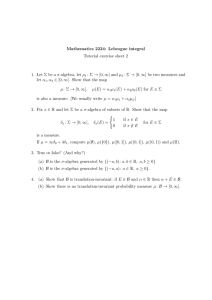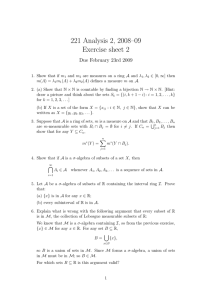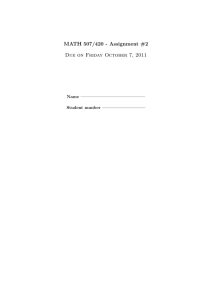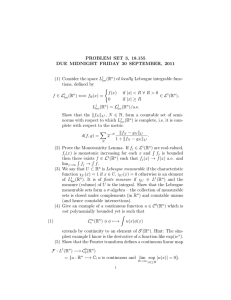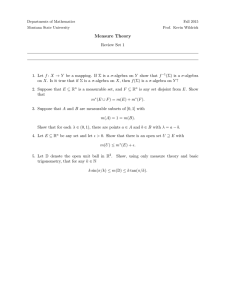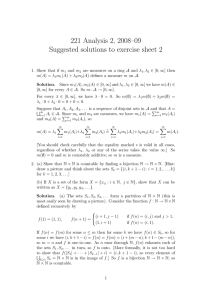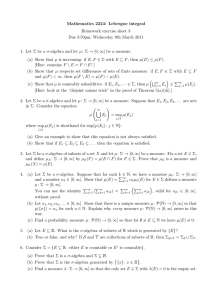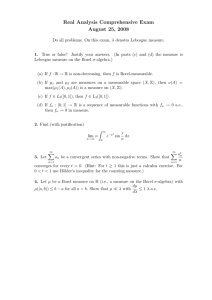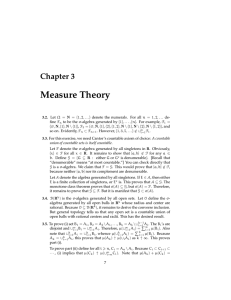Document 13509028
advertisement
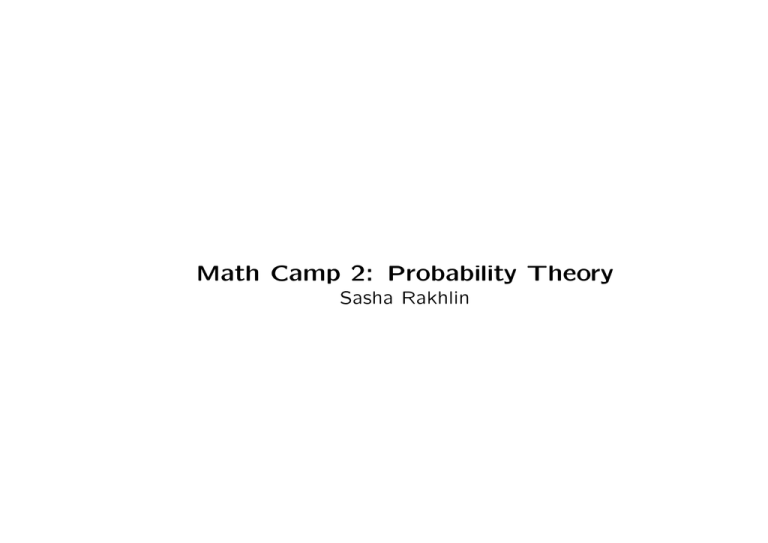
Math Camp 2: Probability Theory
Sasha Rakhlin
σ-algebra
A σ-algebra Σ over a set Ω is a collection of subsets of Ω
that is closed under countable set operations:
1. ∅ ∈ Σ.
2. E ∈ Σ then so is the complement of E.
3. If F is any countable collection of sets in Σ, then the
union of all the sets E in F is also in Σ.
Measure
A measure µ is a function defined on a σ-algebra Σ over a
set Ω with values in [0, ∞] such that
1. The empty set has measure zero: µ(∅) = 0
2. Countable additivity: if E1, E2, E3, ... is a countable
sequence of pairwise disjoint sets in Σ,
⎛
µ
⎝
∞
i=1
⎞
Ei⎠
=
∞
�
µ(Ei)
i=1
The triple (Ω, Σ, µ) is called a measure space.
Lebesgue measure
The Lebesgue measure λ is the unique complete translationinvariant measure on a σ-algebra containing the intervals
in IR such that λ([0, 1]) = 1.
Probability measure
Probability measure is a positive measure µ on the mea­
surable space (Ω, Σ) such that µ(Ω) = 1.
(Ω, Σ, µ) is called a probability space.
A random variable is a measurable function X : Ω �→ IR.
We can now define probability of an event
�
�
P (event A) = µ {x : IA(x) = 1} .
Expectation and variance
Given a random variable X ∼ µ the expectation is
�
IEX ≡
Xdµ.
Similarly the variance of the random variable σ 2(X) is
var(X) ≡ IE(X − IEX)2.
Convergence
Recall that a sequence xn converges to the limit x
xn → x
if for any � > 0 there exists an N such that |xn − x| < � for
n > N .
We say that the sequence of random variables Xn con­
verges to X in probability
P
→X
Xn −
if
P (|Xn − X | ≥ ε) → 0
for every � > 0.
Convergence in probability and almost
surely
Any event with probability 1 is said to happen almost
surely. A sequence of real random variables Xn converges
almost surely to a random variable X iff
P
�
�
lim Xn = X = 1.
n→∞
Convergence almost surely implies convergence in proba­
bility.
Law of Large Numbers. Central Limit
Theorem
Weak LLN: if X1, X2, X3, ... is an infinite sequence of i.i.d.
random variables with finite variance σ 2, then
X1 + · · · + Xn P
→ IEX1
−
n
In other words, for any positive number �, we have
Xn =
�
��
�
�
�
lim P �X n − IEX1� ≥ ε = 0.
n→∞
CLT:
�
Xn − µ
lim Pr
√ ≤z
n→∞
σ/ n
where Φ is the cdf of N (0, 1).
�
= Φ(z)
Useful Probability Inequalities
Jensen’s inequality: if φ is a convex function, then
φ(IE(X)) ≤ IE(φ(X)).
For X ≥ 0,
IE(X) =
� ∞
0
Pr(X ≥ t)dt.
Markov’s inequality: if X ≥ 0, then
Pr(X ≥ t) ≤
where t ≥ 0.
IE(X)
,
t
Useful Probability Inequalities
Chebyshev’s inequality (second moment): if X is arbitrary
random variable and t > 0,
Pr(|X − IE(X)| ≥ t) ≤
var(X)
.
2
t
Cauchy-Schwarz inequality: if IE(X 2) and IE(Y 2) are finite,
then
�
|IE(XY )| ≤
IE(X 2)IE(Y 2).
Useful Probability Inequalities
If X is a sum of independent variables, then X is better
approximated by IE(X) than predicted by Chebyshev’s in­
equality. In fact, it’s exponentially close!
Hoeffding’s inequality:
Let X1, ..., Xn be independent bounded random variables,
�
ai ≤ Xi ≤ bi for any i ∈ 1...n. Let Sn = n
i=1 Xi , then for
any t > 0,
�
Pr(|Sn − IE(Sn)| ≥ t) ≤ 2exp �n
−2t2
i=1 (bi
− ai)2
�
Remark about sup
Note that the statement
n
1
�
f (zi)| ≤ �
with prob. at least 1 − δ , ∀f ∈ F , |IEf −
n i=1
is different from the statement
n
1 �
∀f ∈ F ,
with prob. at least 1 − δ , |IEf −
f (zi)| ≤ �.
n i=1
The second statement is an instance of CLT, while the first
statement is more complicated to prove and only holds for
some certain function classes.
Playing with Expectations
Fix a function f , loss V , and dataset S = {z1, ..., zn}. The
�n
1
empirical loss of f on this data is IS [f ] = n i=1 V (f, zi).
The expected error of f is I[f ] = IEz V (f, z). What is the
expected empirical error with respect to a draw of a set S
of size n?
n
1 �
IES IS [f ] =
IES V (f, zi) = IES V (f, z1)
n i=1
![MA2224 (Lebesgue integral) Tutorial sheet 5 [February 19, 2016] Name: Solutions](http://s2.studylib.net/store/data/010730672_1-a892ada8d0a07e1c5cf78400ac6d42a7-300x300.png)
